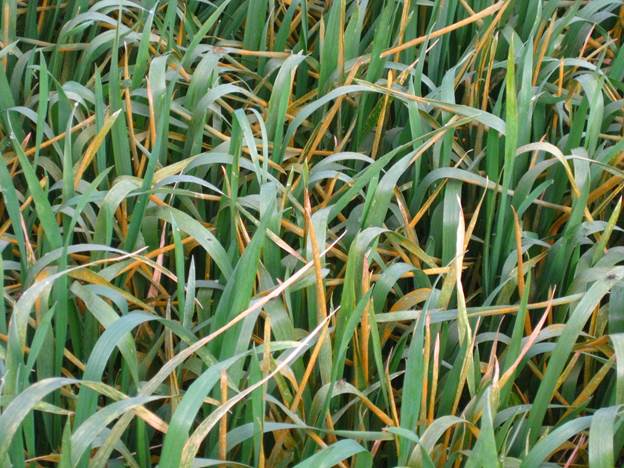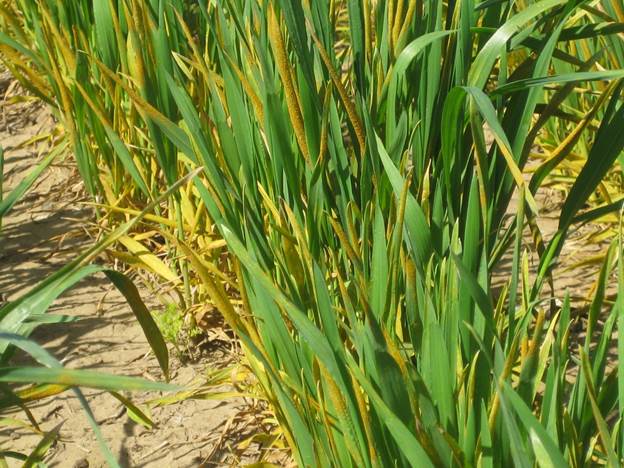Xianming Chen
Stripe Rust in the PNW
We were checking wheat fields in Washington and northeastern Oregon on April 9, 2015. Winter wheat ranged from early jointing (Feekes 4) to late jointing (Feekes 9), and spring wheat ranged from not planted to tillering (Feekes 2). The good news is that no rust was found in any commercial fields checked in Whitman, Garfield, Columbia, Walla Walla, Benton, Franklin, and Adams counties of Washington and Umatilla county of Oregon. The bad news is that stripe rust has developed fast in breeding and rust monitoring nurseries at Central Ferry (Garfield Co.) and Walla Walla (Walla Wall Co.). In the breeding nurseries at Central Ferry, hotspots of several feet in diameter were found in plots of susceptible wheat varieties. In the hotspots, heavy rust pustules were from the bottom to top leaves with up to 90% severity (Fig. 1).
Fig. 1. Wheat plants producing abundant spores of the stripe rust fungus in a nursery at Central Ferry, Washington, April 9, 2015.
In the rust monitoring nursery at Walla Walla, stripe rust developed from few rusting low leaves in the last survey on March 4 to upper leaves of hotspots of several feet long along the susceptible borders. In the hotspots, severity reached 60% (Fig. 2).
Fig. 2. Stripe rust developing in a disease monitoring nursery near Wall Walla, April 9, 2015.
The weather conditions have been favorable to stripe rust since the last stripe rust forecast in early March and predicted to be favorable in the next two to three weeks. The predicted severe epidemic is still held, and thus, fungicide application is recommended for moderate to susceptible varieties. Timing of the fungicide application can be different from region to region. General recommendation is to check fields and apply fungicide when rust can be seen.
Kent Evans checked our winter wheat nurseries at Mount Vernon (Skagit Co.) in northwestern Washington on April 9. As expected, stripe rust was uniform on susceptible check plots and border rows reaching to 50% severity on topper leaves.
We were checking breeding nurseries at the Pendleton and Hermiston experiment stations (Umatilla Co.) in Oregon and did not found rust there.
Barley yellow dwarf was common at Central Ferry and also found at Hermiston.
Based on Mike Flower, stripe rust continues developing in western Oregon. Some previously resistant varieties, such as ‘Rosalyn’, are now susceptible. We will test stripe rust samples from the variety to see if this is dues to any race changes. In our tests, Rosalyn was highly resistant in the fields of several locations in Washington from 2012 to 2014, except intermediate reaction at Walla Walla in 2012 and 2013. In the greenhouse tests, Rosalyn was resistant to races PSTv-14 and PSTv-51, but susceptible to races PSTv-4, PSTv-37, and PSTv-40 in the seedling test under low temperatures. It was resistant to PSTv-14, PSTv-37, and PSTv-40 in the adult-plant tests under high temperatures. The data indicate that Rosalyn has high-temperature adult-plant resistance. From 2010 to 2014, races detected from western Oregon (PSTv-11, PSTv-14, and PSTv-75) are not virulent on seedlings of Rosalyn. The susceptible reaction of Rosalyn could be due to 1) appearance of races virulent on the variety such as the PSTv-37 and PSTv-52 group, which was the most predominant race group throughout the country except western Oregon, and 2) weather conditions not warm enough for HTAP resistance to work. Before the weather warms up for HTAP resistance to be effective, fungicide application is needed to control rust on Rosalyn and varieties with the similar situation.
Stripe Rust in Other States
In addition to Oregon and Washington, stripe rust have been reported in Louisiana, Arkansas, Texas, Mississippi, California, Oklahoma, and Montana. Fungicides have been used to control the disease in these states.

